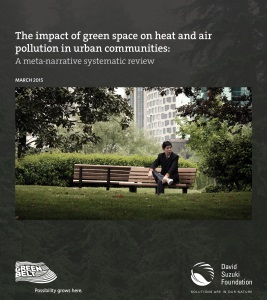
by Brianna Crandall — April 20, 2015—Of interest to urban facilities managers, particularly those with large corporate or educational campuses, a recently released report shows that urban green spaces provide significant health benefits by filtering harmful pollutants from the air and providing cooling effects during extreme heat.
The impact of green space on heat and air pollution in urban communities, from the Canada-based David Suzuki Foundation, documents the impact natural urban spaces — from parkettes to green roofs and large natural spaces like the Ontario Greenbelt — can have on human health and well-being.
Published in collaboration with the EcoHealth Ontario Research Working Group, the report analyzed 102 peer-reviewed scientific studies published over the past five years. It found that these ecological benefits are related to the size, quality and density of the green space.
Research shows that tens of thousands of Canadians die prematurely each year because of acute air pollution, and high summer temperatures lead to increased illnesses, hospitalizations and deaths, especially among older adults. As the population ages and extreme heat waves become more common across the country, urban green spaces can provide essential, natural protection.
The report examined various types and scales of green space, and found that urban green space can provide cooler, cleaner air at the site, neighborhood and city level. Emerging evidence also suggests that closely spaced and connected smaller green spaces can provide greater cooling effects to adjacent urban areas than large individual parks with open grass areas.
The report highlights the exceptional ability of trees to capture and filter air pollutants, including ground-level ozone, sulfur dioxide, nitrogen oxides and particulate matter, and to reduce temperatures at street level and neighborhood scale, particularly during hot seasons and times of day.
The report also highlights growing evidence of disproportionate heat- and air-pollution-related health burdens in neighborhoods with less green space, and suggests that low-income inner-city neighborhoods are generally more vulnerable.
“We hope this report will spark conversations about how to improve the quantity, quality and connectivity of green spaces in our communities, especially in vulnerable urban areas,” said Aryne Sheppard, David Suzuki Foundation.





